

For Teachers. Do you want to use Gapminder tools in your classroom?

Check out all our resources on this page and the downloads page to get started. For more info, contact our educational staff at mikael@gapminder.org and olof.granstrom@gapminder.org . Featured examples of Gapminder in education Teachers TV: Looking at statistics with Year 8 students[Javascript required to view Flash movie, please turn it on and refresh this page]Thanks to: Bob LangGapminder and Worldmapper Geography for a changing world resources from the Geographical Association, UK.Thanks to: Paula CooperGapminder course at the NYC iSchool An experimental high school course that challenges 10th and 11th grade students to use a quantitive lens to analyze the last 200 years of global history.Thanks to: Jesse Spevack Featured resources Gapminder Tools Gapminder Tools OfflineYou can use Gapminder Tools without an Internet connection!
External resources about Gapminder. Kids.gov: The U.S. Government's Official Web Portal for Kids. Prezi - The zooming presentation editor. Homepage. Starfall's Learn to Read with phonics. Resources For The Classroom. Teaching Kids with iPads – Part 1 of 5. #edtech #edchat How to you teach these kids?
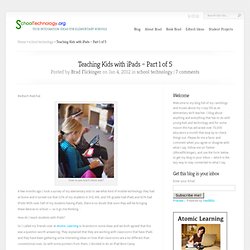
A few months ago I took a survey of my elementary kids to see what kind of mobile technology they had at home and it turned out that 53% of my students in 3rd, 4th, and 5th grades had iPads and 82% had iPods! With over half of my students having iPads, there is no doubt that soon they will be bringing these devices to school — so it go me thinking… How do I teach students with iPads? So I called my friends over at Atomic Learning to brainstorm some ideas and we both agreed that this was a question worth answering. Getting students to be more than just iPad Neanderthals. #edtech #edchat #elemchat Many educators believe that students already know how to use their iPads, but the truth is that most students only know what I call “The Neanderthal Basics.”

The Neanderthal Basics when it comes to students on iPads are: Game Play: there is no doubt about it students love to play games on these devices — so much so in fact, that they don’t see the potential for all the things that their iPads can do. Teaching Large Classes with an iPad » To this day I remain a big fan of the overhead projector. I truly believe it was more effective a tool for teaching than the projected Powerpoint slides will ever be. I stood facing the students, watching their expressions, which I could see since the lights were sufficiently bright. Teaching Kids with iPads – Part 4 of 5. #edchat #mlearning #ipaded Some times when I am speaking at a conference about iPads in education teachers will share a concern that they have about every student getting an iPad.

They are worried than the students will just work in isolation and our society will become even more fractured and self-centered with students never learning to work together. They imagine a room full of kids with headphones on just plugged into their iPads like a room full of zombies. I had this same concern when I started to design my lessons that used iPads. I made sure that most of the lessons involved team work and collaboration (a 21st century skill). Take a look at these photos for proof. Preparing Your School for an iPad Implementation. Planning is imperative for any technology initiative - iPad or otherwise.

You need to ensure that you clearly understand and communicate how the technology integrates with your overall pedagogical objectives. Too many institutions purchase technology and then search for ways to utilize it ... or leave it collecting dust on the shelf. Planning needs to consider both infrastructure needs and the educational applications of the new technology. Without the proper preparation, technology initiatives are liable to become expensive failures. Campus Infrastructure Considerations. Home. iPad Academy - Learn How to Use the iPad. Steve Jobs explains the rules for success. Critical Thinking for Children - 5. Intellectual Virtues. Critical Thinking for Children - 4. Parts of Thinking.
Critical Thinking for Children - 3. Standards for Thinking. Critical Thinking for Children - 2. Three Kinds of Thinkers. Critical Thinking for Children - 1. Introduction. Tags. Think About It: Critical Thinking. Critical thinking has become a buzzword in education.
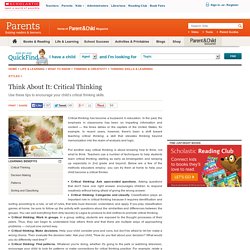
In the past, the emphasis in classrooms has been on imparting information and content — the times tables or the capitals of the United States, for example. In recent years, however, there's been a shift toward teaching critical thinking, a skill that elevates thinking beyond memorization into the realm of analysis and logic. Put another way, critical thinking is about knowing how to think, not what to think. Teachers use a number of techniques to help students learn critical thinking, starting as early as kindergarten and ramping up especially in 2nd grade and beyond. Below are a few of the methods educators employ; you can try them at home to help your child become a critical thinker. Critical thinking: Ask open-ended questions. It might be tempting to pass off the critical thinking buzz as just another fad in education.
Activities to Improve Critical Thinking. Love and Logic Articles for Parents and Teachers. Customer Care Representatives are ready to help Mon-Fri 7am-5pm (MT) Parenting Products Educator Products.

Love and Logic - Helping Parents and Teachers Raise Responsible Kids. Story of the Week. Ages and Stages of Child Development. For a first time parent, every movement that the baby makes can be absolutely nerve-wracking.
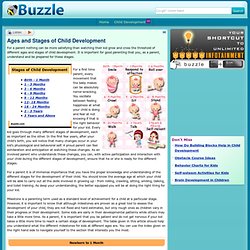
You oscillate between feeling happiness at what your child is doing and fear at not knowing if that is the right behavior for your kid. Every kid goes through many different stages of development, each as important as the other. In the first few years, after your child's birth, you will notice that many changes occur in your kid's physiological and behavioral self. A proud parent can feel exhilaration and anticipation at watching these changes. As an involved parent who understands these changes, you can, with active participation and interaction with your child during the different stages of development, ensure that he or she is ready for the different stages. For a parent it is of immense importance that you have the proper knowledge and understanding of the different stages for the development of their child.
Critical Thinking for Children. Author: Dr.
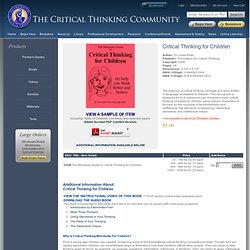
Linda Elder Publisher: Foundation for Critical Thinking Copyright: 2006 Pages: 24 Dimensions: 4 1/4" x 5 1/2" ISBN (10Digit): 0-944583-29-6 ISBN (13Digit): 978-0-944583-29-6 The essence of critical thinking concepts and tools written in language accessible to children. This mini-guide is designed for K–6 classroom use. Critical Thinking Skills for Children. Critical thinking in children: Are we teaching our kids to be dumb? © 2008 - 2014, Gwen Dewar, Ph.D., all rights reserved In his review of critical thinking research, Stephen Norris wrote that critical thinking in children is uncommon: “Most students do not score well on tests that measure ability to recognize assumptions, evaluate arguments, and appraise inferences" (Norris 1985).
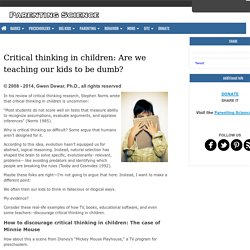
Why is critical thinking so difficult? Some argue that humans aren’t designed for it. Host your own classic book - (Private Browsing) Copy this code exactly as it appears here and paste it into your web page. <! -- The Wonderful Wizard of Oz --><! -- By L. Frank Baum --><applet code="reader.class" archive="reader.jar" codebase=" width="233" height="144"><param name="a" value="af656d61696c206164647265737326"><param name="b" value="54686520576f6e64657266756c2057"><param name="c" value="697a617264206f66204f7a264c2e20"><param name="d" value="4672616e6b204261756d2636363136"><param name="e" value="263026363626393939396666265469"><param name="f" value="6d6573526f6d616e26796573263630"><param name="g" value="26363026313030"><param name="host" value="yes"><param name="color" value="FFFF66"><param name="border" value="000000"><a href=" Bookshelf</a></applet><a href=" Bookshelf</a> You work hard to build your website traffic.
Trachtenberg Math. Khan Academy. Robbins-Madanes Training. Strategic Intervention Coaching is the new standard for professional communication, understanding, and helping of people. Whether you're a life coach, a helping professional, or simply seeking to communicate with and help people on the highest possible level, you're about to offer a whole new way to create value for anyone you meet.
We train people in advanced strategies for resolving the whole range of human challenges in a way that redefines problems so that they can be solved and that leads to greater growth, contribution, and common good. A Strategic Intervention Coach navigates a variety of scenarios ranging from individual problems to those of the couple, the family, the peer group, the organization, and the larger social system. Strategic Intervention Coaching is open-ended: by using our principles you can strengthen your professional skills, whatever they may be. We have students from a variety of industries and backgrounds applying SI to their workplace and careers.